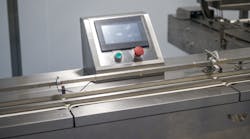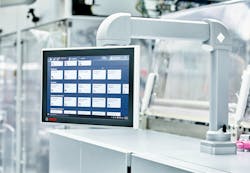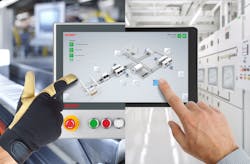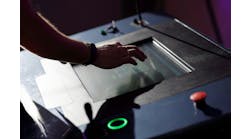A Control Design reader writes: I’ve worked in industrial machine building since before the introduction of the Internet, when machine operator controls were a switch or a pushbutton. Now, our human-machine interfaces (HMIs) control whole systems, visualize how we interact with the machines and collect data for further analysis. Our company has adopted rapidly to new HMI technology, as long as it remains cabinet-mounted. We’ve yet to try any new options for operator interfaces, such as wireless devices, cable-connect HMI pads or HMIs on a swivel arm. We do still have remote access via our cabinet-mounted HMIs, but what might some of these newer options offer that we’re missing out on? What other options are available? How do we weigh them against traditional HMI?
Answers
Tethered, wireless or headless HMI provide continuous automation visualization
For an industrial environment where operators need constant local automation visualization, a traditional panel-mount HMI, using a device able to endure the temperatures, contamination, moisture and other plant-floor conditions typically remains the most preferred option.
HMIs on a swing arm are useful when a large-screen HMI is desired and the operator needs to be able to interact with different points in the machine with both hands and the HMI without walking back and forth from the machine to the HMI. Of course, the HMI needs to be installed in an enclosure rated for the area, or a Video Electronics Standards Association (VESA)-mountable, totally enclosed HMI would be needed, which can drive up costs.
If the environment allows it, and a smaller screen size is acceptable, the wireless or tethered—cable—options give the operator the ability to move around the environment while operating, although they may not have both hands free. These devices can be easily damaged in the wrong environment.
The mobile device connects via a wireless network to the headless HMI, and operators use the app on the mobile device of their choice to access HMI screens. This way only the mobile HMI is exposed. The headless HMI can also drive an external display, fulfilling the previous installations discussed by connecting an industrial monitor that is panel-mounted or VESA-mounted to a swing arm.
Bobby Thornton, product engineer for HMI and Click PLCs / AutomationDirect
Visualization capabilities enhance HMIs
The HMI world has definitely taken advantage of smaller and more powerful semiconductors like in consumer electronics. Having more powerful microcontrollers, opens the opportunity to have HMI devices that not only act as local display and control for the operator, but also as full-blown PLCs with visualization. This is a cost-effective solution on mid-range control applications and modular-type machines. These types of devices will control, display, trend and communicate to upper-level systems, if needed. They could potentially act as your edge controller for IIoT applications. On top of that, there are device variants rated up to IP67, where a cabinet is no longer needed. An HMI is no longer a simple display and could become the cornerstone of the control system with the appropriate hardware for the application. Available communication interfaces range from Modbus remote terminal unit (RTU) to open platform communications unified architecture (OPC UA) and support for a variety of industrial Ethernet fieldbuses, making them ideal for modern automation systems in a wide range of industries.
Roberto Solis, senior product manager, fieldbus technology / Turck
Mobile technology is spreading intelligence across the machine
It sounds like you’re ahead of the curve. HMI design is often one of the last things that machine builders and their end customers focus on. But it significantly impacts people’s ability to operate machines effectively and their opinions of the system overall. Moving forward, you should watch for several upgrades in terms of hardware capabilities, software functionality and machine-design trends. And the concerns about PC-based control are really perceived risks. Many of our customers have been successfully using PC control in the field for decades—specific to HMI, most of these customers have been able to eliminate the stand-alone PC used for the HMI, so there’s an immediate hardware reduction and better synchronization of all HMI and control components.
Whether it’s on a pole, swivel arm or built into the cabinet, HMI hardware should be ruggedized with options for solid aluminum and hygienic stainless steel, as well as flexibility for customization (Figure 2).
We enjoy helping engineers design the perfect control panel for their machines. That might mean adjusting color schemes and adding logos to fit corporate-branding guidelines. Or it could be adding a full range of e-stops, pushbutton extensions, keyed access or radio-frequency-identification (RFID) readers for managing credentials, jog buttons and handwheels for CNC applications.
Still, you could make the most incredible panel out there, but the functionality has to match the application. I don’t know many people who like clicking through 500 commands to set a parameter. In fact, most customers and equipment end users tell us their operator interface must be as simple as using a smartphone. Otherwise, they face major hurdles in training, considering the ongoing labor shortage.
From a software perspective, people want HMIs to be truly customizable, flexible and adaptable. A fully integrated HMI package should be built from the ground up based on standardized web-based technologies (Figure 10). A modern web application is every bit as capable as the native platform apps of yesteryear, with the added benefit of compatibility across any device with a browser. So with a secure login, you can access the machine from a smartphone, tablet, wireless pendant or other mobile technology.
This translates to an HMI package that unlocks all the potential of contemporary web development. The list of advantages is long, but it includes responsive design—one codebase for all devices— unlimited graphical and styling customization, a powerful scripting environment and open-source software integration.
So, if you’re already doing this, why does it matter if your HMI hardware is built into a cabinet or remote? Well, the machine design is headed toward cabinet-free concepts. This is increasingly made possible by IP67-rated control solutions like industrial PCs, drives and I/O modules that can mount directly on machines. Maybe it’s just spreading intelligence across the machine to make cabinets smaller. Either way, your HMI will likely need to move. A pole mount is great if that panel can be stationary. However, we’ve seen many swivel arms that help to deliver an operator interface that’s physically connected to the machine but can move with the operator as they start or examine different processes.
It all starts with thinking about the HMI early in the design process—not to say you couldn’t add a more fitting panel later. But an industrial control panel that’s optimized for branding, operation and machine design can provide the perfect touch.
Eric Reiner, IPC product manager / Beckhoff Automation
On-machine equipment offers improved operator ergonomics and line of sight
When it comes to HMI, on-machine options are especially attractive. Mounting them on swing arms and attaching optional side handles can help increase operator comfort with improved ergonomics and give operators line of sight to critical process areas. You can also combine on-machine terminals and PCs with hardwired buttons and selector switches since both include options for embedded pilot devices, as well as a hard-wired emergency-stop button. If your facility already has HMI hardware and software, rest assured that you can add on-machine devices while maintaining consistency with your installed base. On-machine industrial PCs can also run application software, which offers cloud-based collaborative HMI development. On-machine monitors which could be paired with an enclosure-mounted box PC or thin client are on the horizon. It's an exciting time to be involved in industrial machine building with on-machine equipment offering you new opportunities for saving space, time and money.
Al Letourneau, senior commercial portfolio manager, visualization & computing platforms / Rockwell Automation








